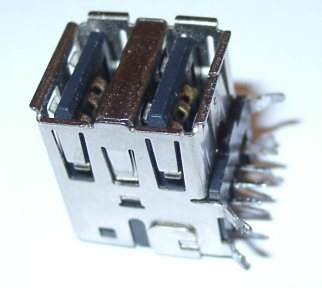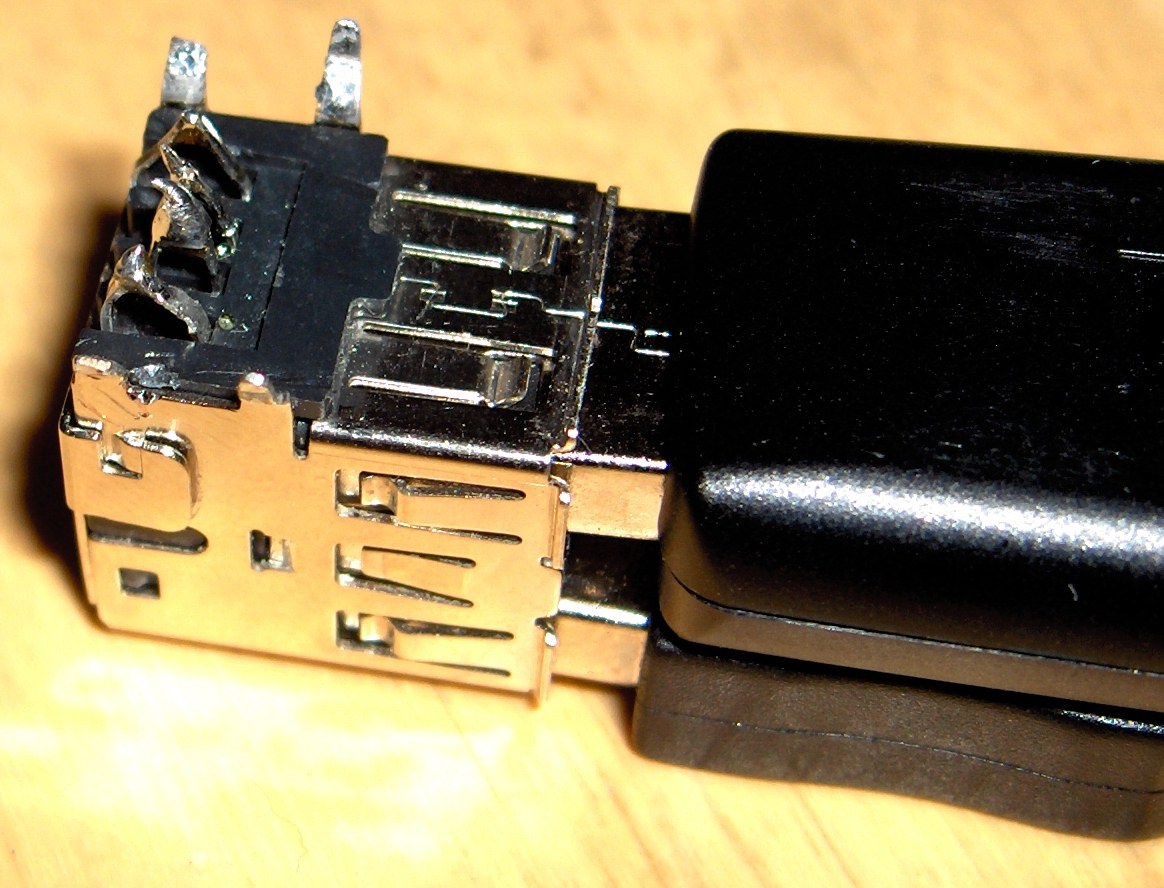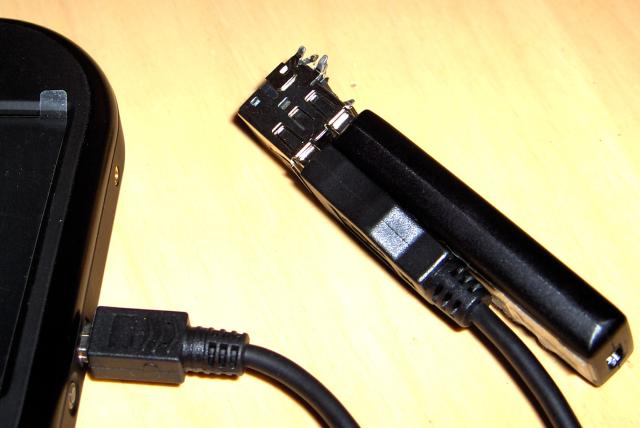Specialized USB cables
From Openmoko
(→Modified USB cable to inject power while in host mode) |
|||
| Line 1: | Line 1: | ||
{{note|work in progress}} | {{note|work in progress}} | ||
| − | === | + | == Attaching the Neo (acting as a USB host) to a USB device == |
| + | |||
| + | The USB port (5 position mini type B jack) on the Neo 1973 and Neo FreeRunner can be both a USB device or a USB host. The provided cable (5 position mini type B plug to type A plug) is used when attaching the Neo to a USB host. | ||
| + | |||
| + | A specialized cable is required when attaching the Neo to a USB device. | ||
| + | |||
| + | Alternately, an adapter capable of connecting two type A plugs will allow attaching the provided USB cable to the USB cable that came with the USB device. This adapter is also known as a gender changer. These can be purchased or made. | ||
| + | |||
| + | === How to make a mini type B plug to a type A jack cable === | ||
| + | |||
| + | (picture) | ||
| + | |||
| + | (digikey part number for mini type B plug) | ||
| + | (digikey part number for type A jack) | ||
| + | (digikey part number for cable) | ||
| + | (construction instructions) | ||
| + | |||
| + | ==USB cable for inject power while in host mode == | ||
| + | |||
| + | Attached USB devices may require more current than the 500mA that the FreeRunner can deliver. | ||
| + | |||
| + | A specialized cable is required when attaching the Neo to a USB device. | ||
| + | |||
| + | |||
| + | |||
| + | === Modified USB cable to | ||
Three-headed cables are required if you want to power the FreeRunner / USB device whilst in host mode. For many uses the FreeRunner provides sufficient power to make such a cable unnecessary. At the moment, you'll have to manufacture this one yourself. You need to make a cable with three ends: | Three-headed cables are required if you want to power the FreeRunner / USB device whilst in host mode. For many uses the FreeRunner provides sufficient power to make such a cable unnecessary. At the moment, you'll have to manufacture this one yourself. You need to make a cable with three ends: | ||
Revision as of 06:33, 30 August 2008
| NOTE: work in progress |
Contents |
Attaching the Neo (acting as a USB host) to a USB device
The USB port (5 position mini type B jack) on the Neo 1973 and Neo FreeRunner can be both a USB device or a USB host. The provided cable (5 position mini type B plug to type A plug) is used when attaching the Neo to a USB host.
A specialized cable is required when attaching the Neo to a USB device.
Alternately, an adapter capable of connecting two type A plugs will allow attaching the provided USB cable to the USB cable that came with the USB device. This adapter is also known as a gender changer. These can be purchased or made.
How to make a mini type B plug to a type A jack cable
(picture)
(digikey part number for mini type B plug) (digikey part number for type A jack) (digikey part number for cable) (construction instructions)
USB cable for inject power while in host mode
Attached USB devices may require more current than the 500mA that the FreeRunner can deliver.
A specialized cable is required when attaching the Neo to a USB device.
=== Modified USB cable to
Three-headed cables are required if you want to power the FreeRunner / USB device whilst in host mode. For many uses the FreeRunner provides sufficient power to make such a cable unnecessary. At the moment, you'll have to manufacture this one yourself. You need to make a cable with three ends:
- A mini-USB type B cable for the Neo itself
- A cable of whatever type to go to your USB device.
- A cable going to a +5V +/-10%(max!) power supply with enough power for your device and to charge the Neo. This could be a wall charger or even another USB plug.
You connect the Data+ and Data- wires of the Neo and the device, and connect all of the ground wires together and all of the +5V wires together. This powers the Neo and the device, while letting the neo talk to the device. You have to connect 2pcs 15kOhm resistors, one from D+ to ground, and one from D- to ground, to comply with USB-spec for hostmode, as Neo is switching off the internal resistors when you enable charging/powering over USB by asserting EN_USBHOST. See schematics, LOCATION:49XX
Just for reference, the USB wires from left to right are:
- Black: Power -
- Green: Data -
- White: Data +
- Red: Power +
The Mini_USB-B connector has a fifth pin, the ID-pin. This pin is supposed to be short to ground to signal Freerunner to enter hostmode. For the Y-cable and enabling external power while in hostmode, you may connect a 47kOhm resistor from ID-pin to ground. This is the same trick the OM-wallcharger uses to signal to Freerunner it can charge with 1A. Future kernels should switch to hostmode + external power when seeing this 47k resistor.
DIY USB host adapter
Note that these instructions are provided in the hope that they are useful but without any warranty!
- Find an old motherboard with a set of two USB receptacles as shown above.
- Desolder this set of receptacles from the motherboard. This can be bit tricky but it is doable at least with a desoldering gun.
- Each receptacle has four pins. Use a multimeter to verify that you have no short circuits between the pins or the shield.
- Solder adjacent pins together (GND to GND, D- to D-, D+ to D+, VCC to VCC).
- (Optional) Build a test cable. Cut an USB cable with A plug into half, connect it a receptacle and again measure that you have no short circuits. Then connect the test cable to PC and verify that you see
black GND green 0V white 0V red +5V
- Freerunner is shipped with a mini-B-to-A-plug cable. Connect this to a receptacle.
- (Optional)Connect test cable to the other receptacle and verify that you see
black GND green 0V white 0V red 0V
when freerunner acts as a device and
black GND green 0V white 0V red +5V
when it acts as a host.
- At your own risk, switch freerunner to USB host mode and connect an USB device to the other receptacle of the adapter. Here's how the setup should look like:
Compatibility
The adapter works with kingston data traveller 4G memory stick and aiptec pencam webcam. However, for some reason (probably the missing 15k resistors at D+ and D-) it did not work with any of the tested USB keyboards or mice:
usb 1-2: new full speed USB device using s3c2410-ohci and address 24 usb 1-2: device descriptor read/64, error -62 usb 1-2: device descriptor read/64, error -62 usb 1-2: new full speed USB device using s3c2410-ohci and address 25 usb 1-2: device descriptor read/64, error -62 usb 1-2: device descriptor read/64, error -62 usb 1-2: new full speed USB device using s3c2410-ohci and address 26 usb 1-2: device not accepting address 26, error -62 usb 1-2: new full speed USB device using s3c2410-ohci and address 27 usb 1-2: device not accepting address 27, error -62
However, if I connect neo to small (unpowered) USB hub
usb 1-2: new full speed USB device using s3c2410-ohci and address 61 usb 1-2: configuration #1 chosen from 1 choice hub 1-2:1.0: USB hub found hub 1-2:1.0: 4 ports detected
and connect the keyboard to the hub then it is correctly recognized:
usb 1-2.3: new low speed USB device using s3c2410-ohci and address 62 usb 1-2.3: configuration #1 chosen from 1 choice input: USB Keyboard as /devices/platform/s3c2410-ohci/usb1/1-2/1-2.3/1-2.3:1.0/input/input13 input: USB HID v1.10 Keyboard [ USB Keyboard] on usb-s3c24xx-2.3 input: USB Keyboard as /devices/platform/s3c2410-ohci/usb1/1-2/1-2.3/1-2.3:1.1/input/input14 input: USB HID v1.10 Device [ USB Keyboard] on usb-s3c24xx-2.3
With the hub I can also use both keyboard and usb memory stick at the same time.
Power consumption
When I unplug the USB hub (with only keyboard connected to it) the power consumption estimate at /sys/devices/platform/bq2700-battery.0/power_supply/bat/current_now decreases from 175000 to 145000 (are these microamperes?).



